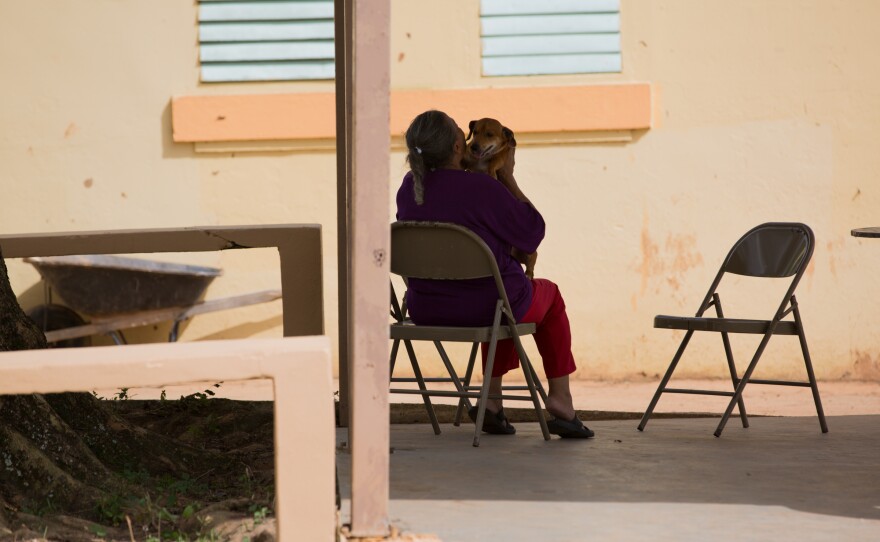Blanca Ortiz-Torres was sitting in a Puerto Rican oasis. She was at a working bakery in the tiny mountain town of Maricao that had both a generator and a cistern and, as a result, could serve cold drinks, hot coffee, fresh pastries, and pizza.
Lea estahistoria en español. / Read this story in Spanish.
But she wasn’t happy about it. She and a volunteer team of doctors, nurses, and psychologists didn’t travel three hours from San Juan to one of the smallest towns on the island to have a snack. They came to assess residents left homeless after Maria. But, when they arrived, the Puerto Rican health official in charge told them that only a handful of the expected refugees had been brought to the shelter.
So, Ortiz-Torres and the team went across the street to kill time, have coffee, and vent.
“What you’re just seeing is part of what has been the greatest weakness in this whole process. Lack of logistics and coordination,” she said. “It’s like wasting time and resources. We could be helping people. But that has been since day one what we have been facing in Puerto Rico.”

Ortiz-Torres is a psychologist and a professor at the University of Puerto Rico. She and others are working to bring health care and basic medicines to housing shelters in remote parts of the island – part of a larger effort that’s been ongoing since Hurricane Maria passed.
Dr. Domingo Caceres Ortiz has a private family practice and is part of the effort. He, too, was frustrated. The winding drive here through the hills wasn’t easy; going back in the dark wouldn’t be, either.
“There’s no coordination with the health department and what we’re doing,” he said. “We’re wasting our time. We can do a lot of things with these people.”
Ortiz-Torres said this day’s small logistical failure is evidence of something much bigger, and the bakery -- with a tarp on its failing roof and a generator humming -- is proof.
“If we recover from this, it’s not because of the government. It’s because of the civil society. It’s individuals,” she said. “Many people here were under the illusion that we were like a first world country. And now they see that we are not. That we are a poor country. That we are in really bad shape. And how fragile our infrastructure, our economy is. Now they’re seeing that.”

Luis Colón thinks he knows why. He’s a taxi driver, a student in psychology, and he came on the trip, too. He says that, just as Maria stripped the leaves from the island’s trees, making it easier to see the forest, so too did it clear the way for Puerto Ricans to see more about themselves.
“Now, we can see through the trees, stuff that we didn’t see before...because we were in our comfort zones, you know?” Colón said. “Not aware of the necessities of other towns and other people. And that’s what is shocking everywhere you go.”
Eventually, the group left the café and crossed the street to an old school building and its covered basketball court. This was to be Maricao’s new shelter. One elderly woman was there with her son, who told Ortiz-Torres that his mother hadn’t let go of her dog since the storm. Another man sought individual counseling from a psychologist.

And then there was Abigail Ruiz. She lived with her family in a metal-roofed house on the hill above the school until Maria tore half of that roof off. Once the rain started coming in, she and her husband said they had no other choice but to leave. So they went to the old school, broke in, moved all of their belongings down the hill, and made a new home. They’ve been there since three days after Maria hit.
“It was hard, but I had to do it for my children,” she said. “But the truth is I didn’t have anywhere to go, anywhere to live. And the house is not in a condition to be lived in.”


With that, the Ruiz family became the first family to call this school home – but not the last. The plan is to make it Maricao’s main shelter. But, by the time the team of health workers left, few had yet to arrive.
So Ortiz-Torres left as she began. Frustrated. Because the longer it takes to meet basic needs, the longer it will take for people to get back to normal. And to start to care for their bodies and their minds.
“We would have hoped to serve more people. But, at least, I think we’re being effective,” she said. “So, if we get to five, although it’s disproportionate given all of the resources here, at least…” At least, she said, those five people were seen before this team made its long trip home.
This story is part of “The Island Next Door,” WNPR’s reporting project about Puerto Rico and Connecticut after Hurricane Maria.













